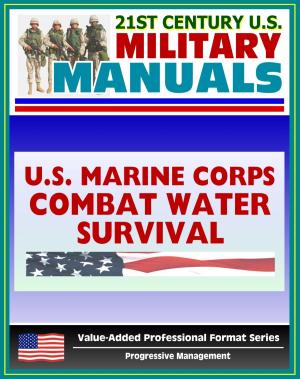Defense Science Board Task Force Report: Force Protection in Urban and Unconventional Environments: Training Regime, Tactical Intelligence, Red Teaming, Role for Technology, SSTR Operations
Nonfiction, History, Military, United States| Author: | Progressive Management | ISBN: | 9781311556684 |
| Publisher: | Progressive Management | Publication: | November 26, 2014 |
| Imprint: | Smashwords Edition | Language: | English |
| Author: | Progressive Management |
| ISBN: | 9781311556684 |
| Publisher: | Progressive Management |
| Publication: | November 26, 2014 |
| Imprint: | Smashwords Edition |
| Language: | English |
The Under Secretary for Acquisition, Technology, and Logistics (USD [AT&L]), the Chairman of the Joint Chiefs of Staff, and the Director, Defense Research and Engineering requested the Defense Science Board (DSB) to form a task force to evaluate force protection in the context of post- major combat operations that have been conducted in Iraq and Afghanistan. The task force has assumed that such operations include stability, security, transition, and reconstruction (SSTR); counterinsurgency; and related operations that can occur in situations other than post-major combat. Attributes that contribute to the challenge of these missions include: Multiple objectives, some in tension with others, Military intermingled with civilians, Adaptive adversaries hidden within the populace, No front lines - all forces at risk, Protracted operations lasting for years.
As directed, the task force's focus was not on short-term fixes, but rather on preparing the Department to meet future challenges. Discussions with active duty officers with recent operational experience in Iraq have had a considerable effect on its findings. its members also learned from visits to U.S. Army and Marine Corps training sites and from a variety of other presentations, including those given by British and Israeli officers about their experiences with force protection in similar operations.
Force protection is not an end in itself. Furthermore, protecting the force is not only, or even mainly, about defensive measures. To the extent that "force protection" connotes bunkers and barbed wire, it is not a helpful term. The task force did not attempt to define force protection, but heard and agreed that protecting the force depends on information, an offensive mindset, winning trust, hearts and minds, as well as defensive measures.
One division commander emphasized that providing services -sewer, water, electricity, trash (SWET) - was his most effective force protection measure. In such circumstances, to paraphrase a chart from the National Training Center, money, food, water, medicine, employment, recognition, and respect are all ammunition (and armor). Ultimately, protecting the force while accomplishing the mission depends on all of these elements guided by realistic objectives and sound strategy, as well as sufficient boots on the ground.
SUMMARY OF FINDINGS AND RECOMMENDATIONS * Recommendations * INTRODUCTION * The Future of Force Protection * THE COMPRESSION OF STRATEGIC, OPERATIONAL, AND TACTICAL LEVELS IN SSTR OPERATIONS * THE TRAINING REGIME * Professional Military Education * INFORMATION OPERATIONS * TACTICAL INTELLIGENCE AND RED TEAMING * RAPID LEARNING AND SHARING OF EXPERIENCE * THE ROLE FOR TECHNOLOGY * JOINT URBAN OPERATIONS ACTIVITY AT JOINT FORCES COMMAND * CONCLUSION * APPENDIX A. TERMS OF REFERENCE * APPENDIX B. TASK FORCE MEMBERSHIP * APPENDIX C. BRIEFINGS, DISCUSSIONS AND VISITS * APPENDIX D. ACRONYMS
The Under Secretary for Acquisition, Technology, and Logistics (USD [AT&L]), the Chairman of the Joint Chiefs of Staff, and the Director, Defense Research and Engineering requested the Defense Science Board (DSB) to form a task force to evaluate force protection in the context of post- major combat operations that have been conducted in Iraq and Afghanistan. The task force has assumed that such operations include stability, security, transition, and reconstruction (SSTR); counterinsurgency; and related operations that can occur in situations other than post-major combat. Attributes that contribute to the challenge of these missions include: Multiple objectives, some in tension with others, Military intermingled with civilians, Adaptive adversaries hidden within the populace, No front lines - all forces at risk, Protracted operations lasting for years.
As directed, the task force's focus was not on short-term fixes, but rather on preparing the Department to meet future challenges. Discussions with active duty officers with recent operational experience in Iraq have had a considerable effect on its findings. its members also learned from visits to U.S. Army and Marine Corps training sites and from a variety of other presentations, including those given by British and Israeli officers about their experiences with force protection in similar operations.
Force protection is not an end in itself. Furthermore, protecting the force is not only, or even mainly, about defensive measures. To the extent that "force protection" connotes bunkers and barbed wire, it is not a helpful term. The task force did not attempt to define force protection, but heard and agreed that protecting the force depends on information, an offensive mindset, winning trust, hearts and minds, as well as defensive measures.
One division commander emphasized that providing services -sewer, water, electricity, trash (SWET) - was his most effective force protection measure. In such circumstances, to paraphrase a chart from the National Training Center, money, food, water, medicine, employment, recognition, and respect are all ammunition (and armor). Ultimately, protecting the force while accomplishing the mission depends on all of these elements guided by realistic objectives and sound strategy, as well as sufficient boots on the ground.
SUMMARY OF FINDINGS AND RECOMMENDATIONS * Recommendations * INTRODUCTION * The Future of Force Protection * THE COMPRESSION OF STRATEGIC, OPERATIONAL, AND TACTICAL LEVELS IN SSTR OPERATIONS * THE TRAINING REGIME * Professional Military Education * INFORMATION OPERATIONS * TACTICAL INTELLIGENCE AND RED TEAMING * RAPID LEARNING AND SHARING OF EXPERIENCE * THE ROLE FOR TECHNOLOGY * JOINT URBAN OPERATIONS ACTIVITY AT JOINT FORCES COMMAND * CONCLUSION * APPENDIX A. TERMS OF REFERENCE * APPENDIX B. TASK FORCE MEMBERSHIP * APPENDIX C. BRIEFINGS, DISCUSSIONS AND VISITS * APPENDIX D. ACRONYMS















